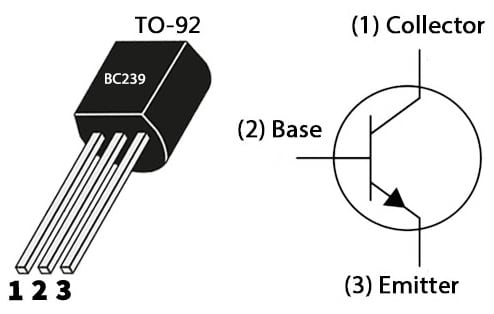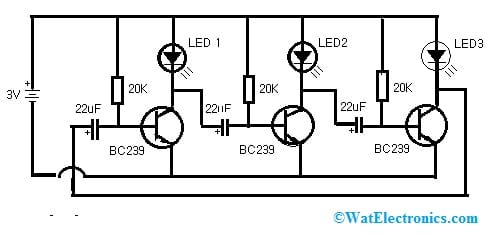Small signal transistors come in both PNP & NPN forms which are used for amplifying low-level signals and also they can be used as a switch. These transistors mainly depend on the contact between two different kinds of semiconductors to amplify or switch electronic signals & power. The typical hFE values for these transistors range from 10 to 500 with the highest IC ratings ranging from 80 to 600mA. The maximum operating frequencies of these transistors range from 1 to 300 MHz. These transistors are used in almost every modern electronic device. This article provides brief information on one of the small signal transistors like a BC239 transistor, pinout, specifications, and its applications.
What is BC239 Transistor?
The BC239 is an NPN silicon general-purpose transistor that is mainly designed for use in linear & switching applications. This transistor is manufactured in a TO-92 plastic case which is designed mainly for medium power applications. The complementary transistor of BC239 is the BC307 PNP transistor. These transistors are used in low-noise AF input & driver stages.
Pin Configuration:
The pin configuration of the BC239 Transistor is shown below. This transistor includes three terminals that carry electrical current to help in making a connection to electronic circuits. The functions of each terminal are discussed below.

BC239 Transistor Pin Configuration
Pin1 (Collector): It is a positive lead of the transistor and is indicated with the ‘C’ letter. This terminal is larger as compared to both the base & emitter terminals and it is doped moderately. The main function of this terminal is to collect charge carriers which are sent by the emitter through the base terminal.
Pin2 (Base): This terminal is used to activate the transistor and is indicated with a ‘B’ letter. This terminal size is thin and doped lightly. The main function of this terminal is to pass the charge carriers from the emitter terminal to the collector.
Pin3 (Emitter): It is a negative lead of the transistor and is indicated with an ‘E’ letter. This terminal is moderately sized and doped heavily. The main function of this terminal is to supply various majority carriers for supporting the electricity flow.
Connecting a base resistor to the base terminal of the transistor is advisable to avoid it being damaged. Please refer to this link for; Choosing Base Resistance for Transistors in Electronic Circuits.
Features & Specifications:
The features and specifications of the BC239 transistor include the following.
- It is a three-terminal NPN transistor.
- This transistor is made with ‘Si’ material.
- It is available in the TO92 Package.
- Its maximum noise figure is 4 dB.
- Its minimum transition frequency is 150 MHz.
- Its maximum continuous collector current is 0.1 A.
- Its maximum collector-to-emitter voltage is 25 V.
- Its maximum collector to base voltage is 30 V.
- Its emitter to base maximum voltage is 5 V.
- Its collector dissipation is 0.5 W.
- The DC gain or hfe is 120 to 800.
- Its collector current maximum is 0.1 A.
- Its collector capacitance is 5 pF.
- The transfer ratio of forward current (hFE) is 200.
- The operating & storage junction temperature ranges from -55 to +150 °C.
Equivalent & Complementary Transistors
The equivalent and replacement BC239 transistors are; BC172, BC183, BC173, BC237, BC547, BC238, BC548, BC550 or BC549. The complementary BC239 NPN transistor is the PNP BC309 transistor.
The SMD versions of BC239 transistor are; BC848 in SOT-23, BC849 in SOT-23, BC848W in SOT-323, MMBTH10 in SOT-23 (or) BC849W in SOT-323. So all these transistors are similar types having similar parameters & are designed mainly for surface mounting. Replacing a suitable transistor in any circuit based on requirement happens at times. But it is required to know few things on how to replace it, please refer to this; Replacing Transistors in Electronic Circuits: Factors and Considerations.
LED Sequencer Circuit with BC239 Transistors
Generally, an LED sequencer circuit is designed by combining a clock pulse through a counter circuit. The input clock is usually of any type like through an astable multivibrator, discrete components, logic gate, inverter, or dedicated 555 timer IC and the counter can also be of any type like 4-bit, 8-bit, shift registers, or decade. But here, the sequencer circuit is designed by using discrete components.
To make an LED sequencer circuit, discrete components can also be connected based on the charge times of the capacitor & biasing of the transistor. Therefore, here we are going to make an LED sequencer circuit with BC239 NPN transistors.
The required components to make this circuit mainly include; BC239 NPN Transistors-3, LEDs-3, 20K Resistors-3, 22uF Capacitors-3, 3V Battery, battery clips, breadboard, and connecting wires. Connect the circuit as per the circuit shown below.

LED Sequencer Circuit with BC239 Transistors
Working
This circuit is versatile, so you can increase the number of LEDs easily with transistors in a similar way to how we have allied them. This circuit is operated with 3, 6, 9 (or) 12V DC however it is necessary to utilize a current limiting resistor with all connected LEDs in series if your circuit is operated with above 3V.
The working of the LED sequencer circuit is very simple. Once the circuit is made, the 3V DC signal works like a control signal on the first transistor’s base terminal then the first LED will be turned ON. After that, the DC o/p from the first transistor’s collector terminal works as the control signal mainly for the second transistor’s base terminal then the second LED will be turned ON, after a set time delay because of the 22uF capacitor.
After that, the second transistor’s output will go to the third transistor’s base terminal then the LED will be turned ON. So the third transistor’s collector output loops back to the first transistor’s base terminal to perform as a control signal. As a result, the LED sequencer will continue to function within a loop until this circuit power supply is stopped.
The applications of this circuit mainly include; advertising displays, small discos, and different projects like; alarms, clap switches, touch ON/OFF switches, remote-controlled switches & matrix die.
While looking for a suitable transistor for your application based on a few factors, it is very important to look into a few points on How to Select a Transistor. Transistors can also be interfaced with a microcontroller. Read on Interface of a transistor to a microcontroller to know about it. Few precautions need to be taken before interface a transistor to a microcontroller. Read on precautions on interfacing a transistor to microcontroller.
BC239 Transistor Applications
The applications of the BC239 transistor include the following.
- BC239 transistor is used within switching and amplifying devices.
- This NPN transistor is used in DIY kits & electronic projects.
- This general-purpose transistor is mainly designed for low-noise amplifier applications.
- These are used in linear & switching applications.
- These transistors are preferred within low noise AF input stages within tape recorders & driver stages in audio amplifiers, Hi-Fi amplifiers, and TV signal processing circuits.
Please refer to this link for the BC239 Transistor Datasheet.
Thus, this is an overview of the BC239 transistor, pinout, features, specifications, circuit, working, and applications. Here is a question for you, what is BC309 transistor?